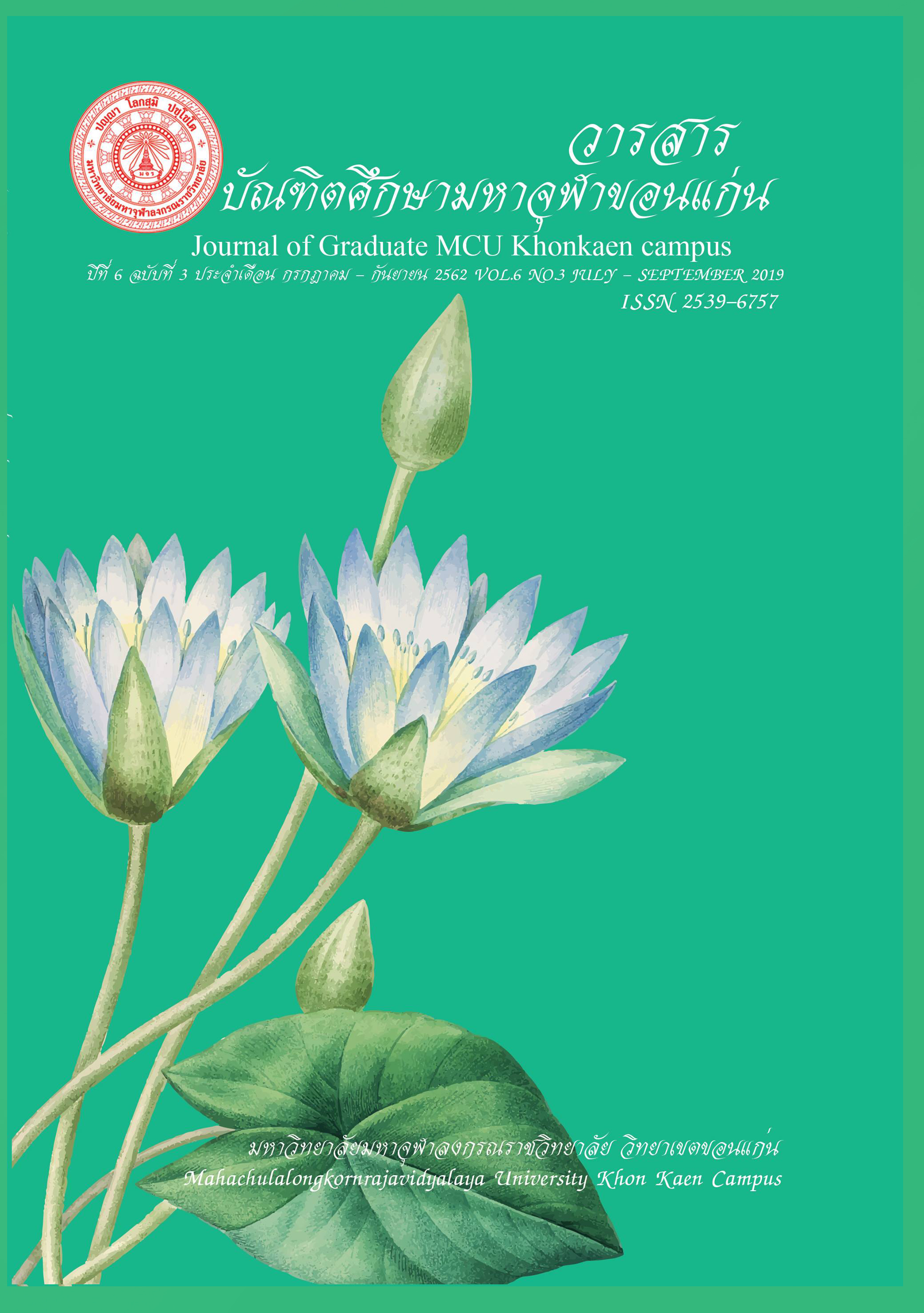การพัฒนากิจกรรมการเรียนการสอน เรื่องวัฒนธรรมและภาษา รายวิชาภาษาไทยพื้นฐาน (ท32102) กลุ่มสาระการเรียนรู้ภาษาไทย ชั้นมัธยมศึกษาปีที่ 5 โดยใช้กิจกรรมการเรียนการสอนรูปแบบซิปปา (CIPPA Model) ที่ใช้สื่อประสม (Multimedia)
Main Article Content
บทคัดย่อ
การวิจัยครั้งนี้มีวัตถุประสงค์เพื่อ 1) พัฒนารูปแบบ CIPPA ที่ใช้สื่อประสม (Multimedia) เรื่องวัฒนธรรมและภาษา 2) ศึกษาผลการใช้รูปแบบ CIPPA ที่ใช้สื่อประสม (Multimedia) เรื่องวัฒนธรรมและภาษา 3) ประเมินประสิทธิผลของรูปแบบ CIPPA ที่ใช้ สื่อประสม (Multimedia) เรื่องวัฒนธรรมและภาษา กลุ่มตัวอย่าง ได้แก่ นักเรียน ชั้นมัธยมศึกษาปีที่ 5/2 โรงเรียนซำสูงพิทยาคม สังกัดองค์การบริหารส่วนจังหวัดขอนแก่น กรมส่งเสริมการปกครองท้องถิ่น กระทรวงมหาดไทย ที่กำลังศึกษาอยู่ในภาคเรียนที่ 2 ปีการศึกษา 2560 จำนวน 33 คน ได้มาโดยการสุ่มแบบกลุ่ม (Cluster Random Sampling) เครื่องมือ ที่ใช้ในการวิจัย ได้แก่ 1) สื่อประสม (Multimedia) เรื่อง วัฒนธรรมและภาษา รายวิชาภาษาไทยพื้นฐาน (ท32102) กลุ่มสาระการเรียนรู้ภาษาไทย ชั้นมัธยมศึกษาปีที่ 5 ที่ผู้วิจัยพัฒนาขึ้น 2) แบบทดสอบวัดผลสัมฤทธิ์ทางการเรียน เรื่องวัฒนธรรมและภาษา รายวิชาภาษาไทยพื้นฐาน (ท32102) กลุ่มสาระการเรียนรู้ภาษาไทย ชั้นมัธยมศึกษาปีที่ 5 เป็นแบบปรนัยชนิดเลือกตอบ 4 ตัวเลือก จำนวน 40 ข้อ 3) แบบวัดการคิดวิเคราะห์ 4) แบบสอบถามความพึงพอใจของนักเรียนชั้นมัธยมศึกษาปีที่ 5 ที่มีต่อการเรียนโดยใช้ สื่อประสม (Multimedia) จำนวน 20 ข้อ 5) แผนการจัดการเรียนรู้ เรื่องวัฒนธรรมและภาษา รายวิชาภาษาไทยพื้นฐาน (ท32102) กลุ่มสาระการเรียนรู้ภาษาไทย ชั้นมัธยมศึกษาปีที่ 5 จำนวน 22 แผน
ผลการวิจัย พบว่า
- รูปแบบการเรียนการสอนแบบ CIPPA ที่ใช้สื่อประสม (Multimedia) เพื่อพัฒนากิจกรรมการเรียนการสอน เรื่อง วัฒนธรรมและภาษา รายวิชาภาษาไทยพื้นฐาน (ท32102) กลุ่มสาระการเรียนรู้ภาษาไทย ชั้นมัธยมศึกษาปีที่ 5 มีองค์ประกอบ 4 องค์ประกอบ คือ 1) หลักการ 2) วัตถุประสงค์ 3) กระบวนการ/ ขั้นตอน 4) การประเมินผล/ผลลัพธ์
- ผลสัมฤทธิ์ทางการเรียนของนักเรียนหลังเรียนสูงกว่าก่อนเรียนอย่างมีนัยสำคัญทางสถิติที่ระดับ .05 ทักษะการคิดวิเคราะห์ของนักเรียนหลังเรียนสูงกว่าก่อนเรียนอย่างมีนัยสำคัญทางสถิติที่ระดับ .05 และความพึงพอใจของนักเรียนที่มีต่อกิจกรรมการเรียนการสอน อยู่ในระดับมากที่สุด
- คุณภาพของรูปแบบการเรียนการสอนแบบ CIPPA ที่ใช้สื่อประสม (Multimedia) เพื่อพัฒนากิจกรรมการเรียนการสอน เรื่องวัฒนธรรมและภาษา รายวิชาภาษาไทยพื้นฐาน (ท32102) กลุ่มสาระการเรียนรู้ภาษาไทย ชั้นมัธยมศึกษาปีที่ 5 ซึ่งประเมินโดยผู้ทรงคุณวุฒิ มีความเหมาะสมอยู่ในระดับมาก
Article Details
เอกสารอ้างอิง
. (2553). หลักสูตรแกนกลางการศึกษาขั้นพื้นฐาน พุทธศักราช 2551.
พิมพ์ครั้งที่3. กรุงเทพฯ : ชุมนุมสหกรณ์การเกษตรแห่งประเทศไทย.
ซำสูงพิทยาคม, โรงเรียน. (2558). หลักสูตรสถานศึกษาโรงเรียนซำสูงพิทยาคม
กลุ่มสาระการเรียนรู้ภาษาไทย. ขอนแก่น : โรงเรียนซำสูงพิทยาคม.
ทิศนา แขมมณี. (2551). ศาสตร์การสอน. กรุงเทพฯ : จุฬาลงกรณ์มหาวิทยาลัย.
บันลือ พฤกษวัน. (2557). แนวพัฒนาการ อ่านเร็ว-คิดเป็น. กรุงเทพฯ: จุฬาลงกรณ์
มหาวิทยาลัย.
มัลลิกา แก้งคำ. (2553). ทฤษฎีการเรียนรู้เพื่อพัฒนากระบวนการคิด. พิมพ์ครั้งที่ 2.
มหาสารคาม : มหาวิทยาลัยมหาสารคาม.
สายจุรี จุติกุล. (2546). สะท้อนความคิดการศึกษาตลอดชีวิต (ออนไลน์). สืบค้นจาก:
https://dnfe5.nfe.go.th/localdata/webimags/srisuree.html.
สิทธิพล อาจอินทร์. (2554). การพัฒนารูปแบบการจัดการเรียนรู้ที่เน้นการคิด.
ขอนแก่น : มหาวิทยาลัยขอนแก่น.

